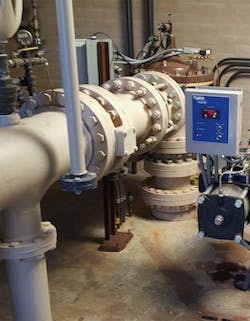About the author:
Alan LeVezu is engineering manager for IDAC West. LeVezu can be reached at [email protected] or 530.613.9938.
In Northern San Diego County approximately 7 miles inland from the Pacific Ocean lies the town of Vista, Calif. Vista was founded in 1882 and quickly grew as its Mediterranean climate proved to be excellent for agricultural homesteaders. During the 1920s, Vista was referred to as the avocado capital of the world. But the town faced many hurdles during its growth including severe drought, a problem that Vista, like the rest of California, faces today.
As the area increased in population, the Vista Irrigation District was created in 1923 to ensure a reliable source of water for the naturally arid region. At the time, local avocado and citrus farms were expanding so rapidly that residents quickly developed serious concerns for the area’s dwindling water supply. To supply local residents with water from nearby Lake Henshaw, the district constructed 14 miles of concrete flume to deliver water from the lake to the irrigation district. In the 1950s, faced with drought and the devastating impact it would have on the agricultural community, Vista Irrigation District sought additional water sources to supplement its local source from Lake Henshaw.
In February 1954, the district joined the San Diego County Water Authority so that it would have the option to receive water imported from northern California and the Colorado River. Since then, the district has persevered through droughts and economic fluctuations, while supporting a massive shift from a predominantly agricultural economy to a more economically diverse community.
Moving Billions of Gallons
Vista Irrigation District aims to provide a reliable supply of high-quality water to meet the needs of its present and future customers in an economically and environmentally responsible manner. The water district transports more than 5 billion gal of water per year. Moving that volume of water requires more than 435 miles of pipeline, monitored and controlled at more than 30 remote sites. These sites consist of pump stations, source water connection points, 12 reservoirs and several flow control facilities. Field locations are woven together via the pipelines to move water throughout the district. The system monitors and controls valve positions, flow rates, pressure and reservoir water levels intelligently—based on the requirements of other system components and zone water usage nearby.
Sourcing, transporting and storing that much water for 127,000 people creates a need for real-time situational awareness of the water transportation system. And during times of extreme drought, the need is even greater, when every measure must be taken to properly manage the resource.
Throughout the water district’s history, technology has played an important role in its ability to support its customers. More than 20 years ago, the district partnered with local automation manufacturer Opto 22 and systems integrator IDAC West. For their first project, Vista Irrigation District and IDAC West needed a remote monitoring and control solution to manage each of the sites.
An Opto 22-based SCADA system was chosen consisting of mistic I/O controllers and G4 I/O modules. Remote sites were networked together using RS-232 serial connections and leased lines from the local telephone company.
The G4 I/O modules came with a lifetime guarantee, and through two decades of service the module and the rest of the Opto 22 system continued to run well. But eventually the district decided it was time to upgrade its current serial-based SCADA hardware platform to an Ethernet-based system.
Upgrading to Ethernet
“After developing a small pilot Opto 22 [programmable automation controller (PAC)] system at our well field at Lake Henshaw, it became very clear that we needed to move forward and upgrade the serial system within our potable water distribution system,” said Frank Wolinski, operations and field services manager for Vista Irrigation District.
Vista Irrigation District puts new technologies into operation using a phased approach. This approach allows the district to spread the costs of technology investments out over time, producing a high return on investment with manageable risk.
The distributed intelligence capabilities of the PAC system allowed IDAC West to prototype, test and roll out upgrades to one remote site at a time. IDAC West was able to run both the existing and new systems in parallel and cut over to the new system when ready.
The research and development (R&D) test center at IDAC West headquarters was used to design and prototype new features of the updated system. This verified that the new controllers, I/O and updated control software were running as intended before cutting over to the upgraded system. Using a SCADA system without distributed intelligence would have required parts of the water distribution system to be taken offline for several weeks to perform a complete upgrade. The combination of distributed intelligence and the R&D test center reduced the district’s downtime for upgrades to just a few hours. For Vista Irrigation District and other end users, the R&D center also is used to provide remote training online, where end users can work with the center’s control systems remotely in near-real time via a high-speed
internet connection.
Distributed Architecture
IDAC West put many of the PAC system features into use during the design and rollout of the new SCADA system. The distributed intelligence of the PAC system allows the district to perform process control at each individual site. Because the controller and brain in the automation system is intelligent, each site continues to operate autonomously via its local control system if network connectivity is lost.
The system also allowed the district to take advantage of the latest networking communications protocols, such as Ethernet and TCP/IP. Each PAC and I/O processor (called a brain) has two built-in Ethernet network interfaces, providing flexibility and redundancy. With built-in Ethernet already on the controller, IDAC West did not need to purchase additional Ethernet cards or upgrade the controller to a higher-priced model to add networking capabilities.
As the SCADA system was transitioned from serial to Ethernet, system performance also was improved. Using the controller’s built-in Ethernet traffic monitoring capabilities, network performance statistics from each remote site can be displayed on a human machine interface at Vista’s headquarters location. This increases visibility into the system and provides the district with near real-time situational awareness of all remote sites.
Where conventional power sources were not available, or were too expensive to install, remote sites are powered by solar panels. The controller and I/O at these solar sites are powered via batteries charged daily through solar panels. The system not only provides control and monitoring for the site, it also monitors the health and performance of the solar system.
Through the use of these products, the district has been able to upgrade its hardware, while maintaining solutions for its legacy systems. Over a 23-year period, the district has migrated through three generations of products, the latest being an Ethernet-based PAC system. Performance has allowed the district to provide reliable service to its customer base

